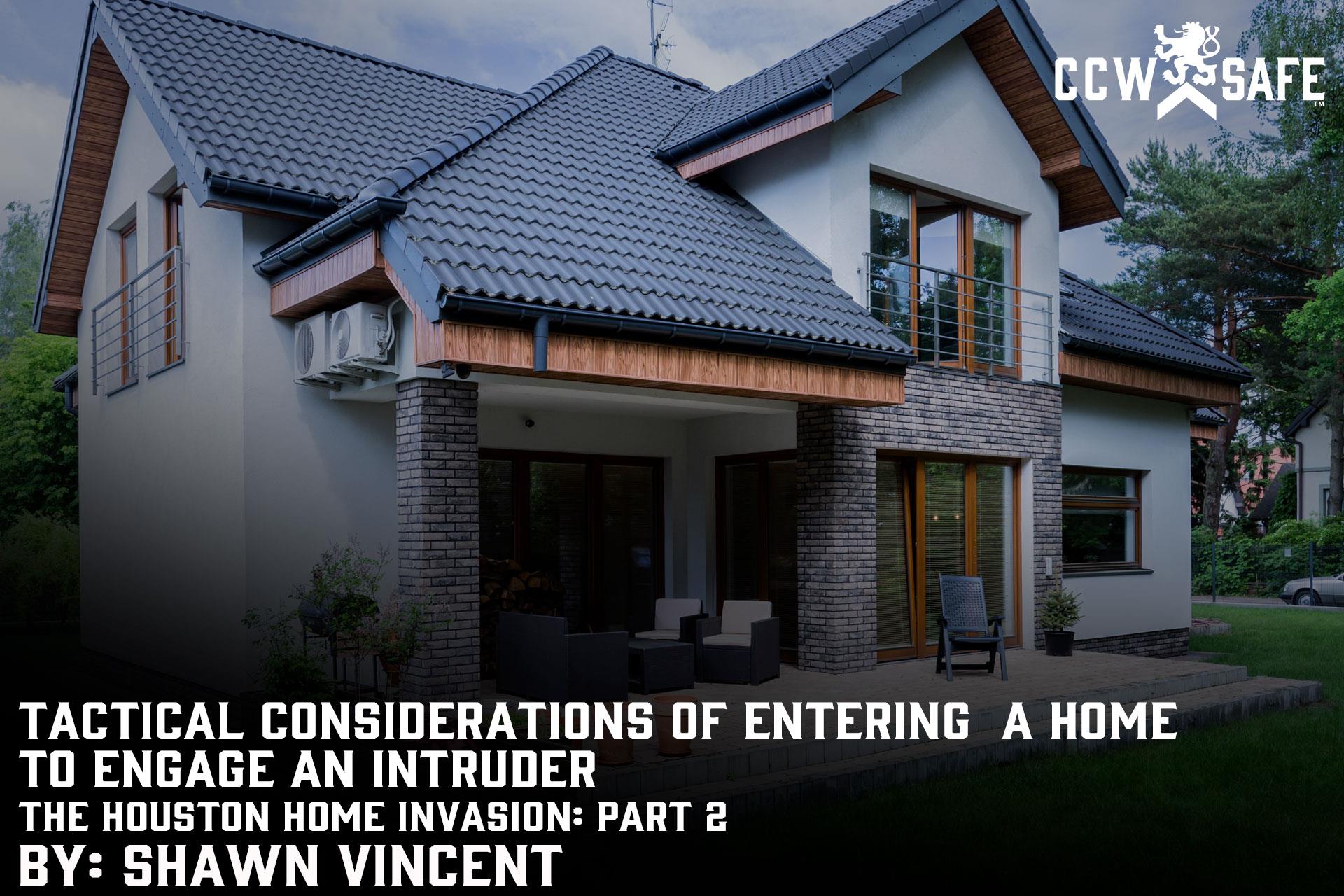
Posted on December 10, 2021
Tactical Considerations of Entering a Home to Engage an Intruder The Houston Home Invasion: Part 2
A young man and his mother returned to their home in Southwest Houston around midnight on April 9, 2019, only to witness a nightmare unfolding. Three intruders had hidden behind bushes and assaulted the father, who arrived home just moments before, and then they forced him inside. The son knew his two teenaged sisters were home and now in danger. Terrified for his loved ones, the young man armed himself and entered the home to confront the invaders and save his family.
In our last article, we explored the legality of leaving a position of relative safety to engage intruders in your home. We cited a Virginia case where a man was prosecuted for entering an unoccupied house he rented, his previous residence, to confront two intruders, and we quoted self-defense law expert attorney Andrew Branca who said, “When you go to the fight, rather than the fight coming to you, that’s not going to look much like self-defense to a lot of people.” Tactical expert and CCW Safe contributor Steve Moses agreed that it is generally a bad idea to enter a home to confront an intruder: “Not unless there’s just some reason you absolutely have to go in there, and typically that’s going to be to protect another family member.”
The son in the Houston invasion case had family members in peril, and he had the legal justification for arming himself and protecting his loved ones, but did he have the tactical chops to pull it off? Neighbors reported eleven shots being fired. Only one ever found its mark, killing one of the intruders. We can assume that the son, courageous as he was, did not possess advanced firearms training, and he almost certainly was not trained in how to breach a building occupied by armed defenders or how to handle a potential hostage situation. The fact that he managed to ward off the intruders without being harmed and without accidentally harming anyone else in the process is an extraordinary bit of good luck.
Successfully entering a building to confront possible armed intruders requires specialized training. “Now we’re discussing movement in structures,” says firearms instructor Tatiana Whitlock. “That is not the equivalent to static shooting at a range from a bench at a paper target. You may have the will to walk into that environment, but you really need to pursue the type of education that will give you the skill to do so safely and make good choices.”
Steve Moses has that training. He once served as a member of a Special Response Team that, under court order, forcibly entered homes, apartments, and mobile homes believed occupied by potentially violent persons in order to enforce Writs of Possession. The teams were highly-trained and armed with rifles. Steve says the average concealed carrier is unlikely to have the tools and the training required to meet an armed threat inside a home. Steve recalls taking Craig Douglas’s “Armed Movement in Structures” course where participants would use airsoft pistols and perform drills. “You would actually get into engagements with persons that were hiding there that had the incentive to shoot you before you shot them,” Steve says, “and all of a sudden, you just really understood that it has to be the most dire of circumstances to go in there and do that.“
An example of one of the many factors an armed defender must consider when entering a structure in defense of others is understanding the difference between cover and concealment. Steve explains that “cover will stop incoming bullet rounds whereas concealment will not.” Most house interiors are constructed with drywall, which will not stop a bullet. “That means there’s actually very little cover within a home,” Steve says. An intruder can fire randomly through walls in the hopes of striking you, but you cannot do the same for fear of injuring or killing the very people you are hoping to save. For this reason, and many others, you are at a tactical disadvantage when entering your home to engage intruders.
It’s difficult to criticize the son for charging in, fighting off the intruders, and saving his whole family. Steve says, “I have a lot of sympathy for that particular person. I can understand the stress that he was under and the fact that he even went ahead and took an action like that.” Nonetheless, working with the assumption that the defender was not exceptionally well-trained, and that he was lucky to have survived the circumstance without anyone in his family being hurt, it’s worth exploring whether there was another way to resolve the situation.
The most obvious alternative would have been to call 9-1-1 and allow law enforcement officers with specific training to engage the intruders. That assumes that the intruders were there to steal, and their motive wasn’t necessarily to kill or injure anyone. The law in Texas allows residents to assume that the intruders who force their way into a home pose an imminent threat, but only the people involved could judge whether these specific intruders intended to cause immediate harm or whether there was time to involve law enforcement. Waiting in such a situation is, admittedly, a huge gamble, but then again, so is charging in and triggering a wild and chaotic shootout.
Tatiana Whitlock says, “You don’t know what you’re walking into,” and she warns that when you rush from the outside to engage intruders in your home, “you subject yourself to single or multiple problems on the inside that may be more armed and more skilled and more dangerous than you.” If you have the time to assess the threat and weigh your options, take that time. The more information you have, the more likely you will be to make good choices that lead to a positive resolution.
Don West, criminal defense attorney and National Trial Counsel for CCW Safe, notes that we don’t have a lot of details from the news reports on this home invasion, but the circumstances are suspicious. Did the father have any reason to believe he was a target? The intruders seemed to be waiting for him. By all accounts, the family seems to exhibit some wealth. Did they invest in security precautions that were equal to the potential threat they faced? Tatiana Whitlock points out that one news report mentioned that the house had a panic alarm that wasn’t working. Would better lighting outside the house have prevented the intruders from being able to hide in the bushes? There are a number of things a home defender can do to make their home a “hard target” and reduce the chance that it will be a target of opportunity.
The lesson for concealed carriers is that you should never leave a relative position of safety outside your home to engage intruders inside unless you have a legitimate concern for the safety of a loved one inside, and even then, you should carefully weigh your options and be honest with yourself about whether you have the tools and the training to successfully execute a dynamic combat maneuver without being killed or putting your loved ones at greater risk. If you’re going to have the heart of a hero, you’d better have the training of a hero. A scenario like the Houston home invasion is exceedingly rare, but as a concealed carrier, you have a responsibility to envision how you would react in different situations and develop the mental mindset required to respond responsibly to any real-world threats that you may face. If defending your home from such an extraordinary attack is a legitimate concern for you, be proactive and implement the security measures necessary to protect yourself and your family before a life-threatening situation unfolds.
